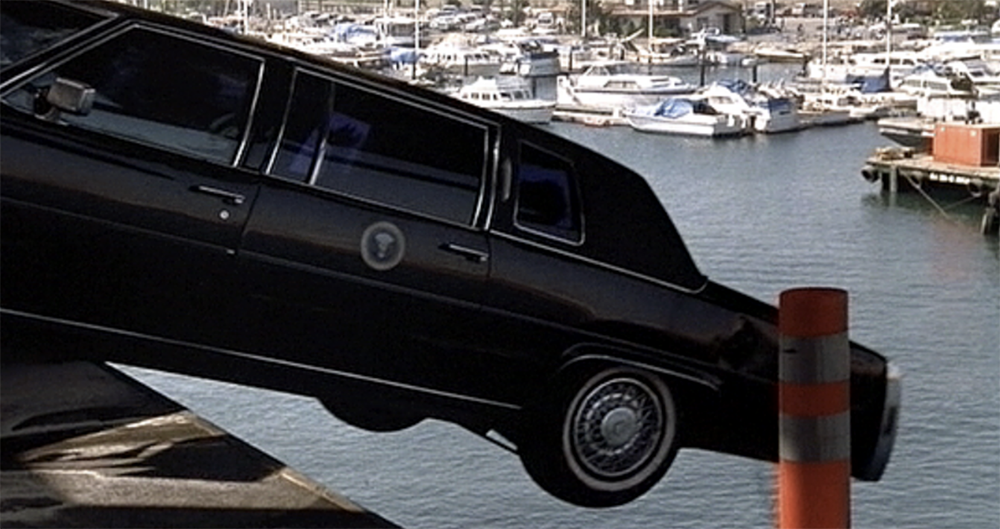Most every tricky movie shot has been done before. But each new trick requires something never exactly done before.
The opening scene in Spy Hard is a spoof of In the Line of Fire.

Leslie Nielsen’s character, Dick Steele, like Clint Eastwood’s character in In the Line of Fire, is an over-the-hill secret service agent. He thinks he hears a gunshot, even though it’s only a kid popping a balloon. He immediately throws the President of the United States into the presidential limousine and it takes off.
Then, to ensure the president’s safety, Leslie starts to chase the president’s limo on foot. The limo approaches a tollbooth at the base of a draw bridge and smashes through the red and white diagonally-striped barrier arm. Leslie, still running, approaches the same tollbooth and smashes through a small red and white diagonally-striped barrier arm meant for pedestrians.
The limo speeds past a warning barrier, slams on the brakes, goes into a skid, does a 180-degree turn, and ends up with its back half hanging over the edge of the open draw bridge, fifty feet above water.
Leslie, his shoes leaving sole tracks (like the tire skid tracks from the limo), also screeches to a halt, also does a 180, and ends up with his heels hanging over the bridge’s edge, also fifty feet above the water. The limo and Leslie teeter. Leslie gingerly reaches into his back pocket and pulls out his fat wallet. He transfers it to his chest pocket, shifting the extra weight, and rights himself, out of danger.
He immediately rushes to the front of the limo, pulls out the special cable embedded in his spy wristwatch, and ties it around the front bumper of the limo. Reeling out the cable as he backs up, he ties the cable to an orange plastic safety cone in the construction barrier, pulling the cable taut.
Just then comes a squawk on Leslie’s headset and he hears, “Steele, Rancor [the bad guy] has been located! We’re coming to pick you up.”
A chopper swoops in and lands. Leslie hops in the chopper. As they’re lifting off, Leslie pulls out a piece of red-and-white-striped barrier he had broken through at the tollgate. He thinks nothing of it and tosses it out the chopper’s open door.
The chip falls slowly down and lands softly on the trunk lid of the limo. This is the final straw. The limo falls and plummets into the drink.
Our location was a drawbridge in San Pedro. We shot all the necessary scenes up to the point of the limo drop. We had cameras covering the limo, the bridge, and a remote camera that would photograph from atop the bridge. The limo was held by a cable hidden beneath a humongous steel plate laid atop the bridge’s tarmac—something that had never been done before.

We were below, on a deck built into the water, to film the action above. The final shot would be the limo falling as the helicopter flies by with Leslie’s double inside the open doorway. We wanted to film the chopper flying directly across the setting sun, just as the limo fell. One take. That’s all we’d get. The Weather Service told us what time the sun would set. That gave us a ten-minute window when the sun was low enough to include in the shot.
We set up to be ready to shoot at 6:00 pm. Then we got a call from the Port Authority. “There’s a boat coming through in fifteen minutes,” the guy said. We had to raise the bridge to its full height. This was like running a full-scale, four-alarm fire drill in the middle of Manhattan in the middle of the night in the middle of summer. We moved in triple speed to do it. The boat came through. We scurried to replace everything. We were set again.
Director of Photography, John Leonetti (The Conjuring and Annabelle),

put his arm around my shoulders and said, “I’m sorry boss, but we gotta change film stock. If we don’t use high-speed film, the water will be black, and the limousine’s already black, and you won’t see a damned thing when it goes in the drink.” I told him to proceed.
Forty of us were on a deck, on the water, below the bridge, looking up at the limo hanging over. I had a remote monitor that showed what the technocrane would see as the chopper flew by the sunset and the limo was cut loose and fell.
I asked the assistant director and chopper pilot on walkie-talkie, “Is there enough time for one rehearsal fly-by for camera?” The pilot replied, “No, but let’s do it anyway.” On cue, he flew the chopper by, in the background. It was too high to cover the sun. I told him to adjust.
We were already late. We had to go. You could’ve heard a pin drop. The A.D. called, “Roll cameras!” and each camera reported in. I called, “Action!” and the chopper began its approach. The special effects guy released the cable holding the limo. The chopper flew by the sun just as the limo dropped. The limo plummeted into the water. The splash shot thirty feet into the air. Everyone applauded and cheered. It was incredible!!!
Elements of this stunt had been done before. But the specific rigs and devices we built were never before used. We were proud that everything came off as planned and was spectacular. Disney, after previews, cut the scene to smithereens. It didn’t have what they love best about cartoon comedies—someone, in close up, hit over the head with a frying pan. But we did something not exactly done before because everyone involved believed we could.


Recent Comments